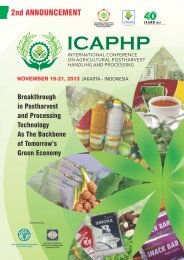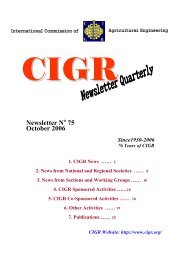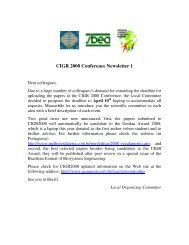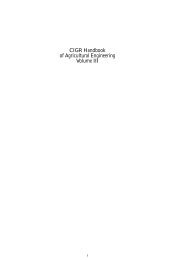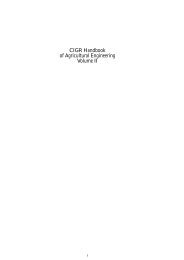CIGR2010-book-abstra..
CIGR2010-book-abstra..
CIGR2010-book-abstra..
Create successful ePaper yourself
Turn your PDF publications into a flip-book with our unique Google optimized e-Paper software.
GROUND WATER RECHARGE IN WAGARWADI WATERSHED THROUGH<br />
RECHARGE PROCESS AND GROUND WATER FLOW MODELS<br />
K. P. GORE 1 , V.V.S. GURUNADHARAO 2 , B.S. NAIK 3 , D. BARMAN 4<br />
1 Head of the Centre, Central Soil & Water Conservation Research & Training Institute, Research Centre (CSWCRTI), Sunabeda, Dist: Koraput<br />
(Orissa) 2 Deputy Director, National Geophysical Research Institute, Hyderabad – 500 007(A.P.) 3 Scientist (SWC Eng.) 4 Scientist (Soil Science),<br />
CSWCRTI, Research Centre, Sunabeda.<br />
CSBE100152 – The Wagarwadi watershed covering 324 ha in Parbhani District, Maharashtra,<br />
India is in the semi tropics and receives a mean annual rainfall of 900 mm. The recharge of the<br />
aquifer, due mainly to rainfall during the monsoon season, was modeled using daily rainfall and<br />
pan evaporation data for 11 years. The recharge water balance accounts for interception loss,<br />
surface runoff, evapotranspiration and soil moisture status. Aquifer parameters viz., transmissivity<br />
and specific yield were estimated through pump tests. The aquifer system was modeled as a single<br />
weathered leaky aquifer using integrated finite technique on a nested square grid. Steady state<br />
conditions were simulated assuming an equilibrium condition during May 1997 which was<br />
considered as the initial water level. During steady state calibration, the transmissivity values were<br />
modified in some pockets to match the computed and observed water level contours. Irrigation<br />
return seepage was found to be contributing significantly to the groundwater regime. The monthly<br />
recharge estimates of the model were fed as input to the aquifer model in transient condition. The<br />
aquifer model was refined and the monthly recharge estimates were found to be adequate for<br />
simulation of water table behaviour. The monthly recharge estimates are very helpful in<br />
determining the magnitude of time – variant input due to rainfall to the aquifer system. The soil and<br />
water conservation practices in the watershed have increased the soil moisture status […].<br />
CONTROLLED DRAINAGE TO IMPROVE EDGE-OF-FIELD WATER QUALITY IN<br />
SOUTHWEST MINNESOTA, USA<br />
S.E. FESER 1 , J.S. STROCK 2 , G.R. SANDS 1 , A.S. BIRR 3<br />
1 S.E. FESER, Dept. Soil, Water, and Climate, University of Minnesota, St. Paul, MN 55108, United States, stacey.feser@co.blue-earth.mn.us.,<br />
1<br />
G.R. SANDS, Dept. Bioproducts and Biosystems Engineering, grsands@umn.edu., 2 J.S. STROCK, Dept. Soil, Water, and Climate & Southwest<br />
Research and Outreach Center, University of Minnesota, Lamberton, MN 56152, jstrock@umn.edu., 3 A.S. BIRR, Minnesota Dept. of Agriculture,<br />
Rochester, MN 55906, Adam.Birr@state.mn.us.<br />
CSBE100154 – Wet, poorly drained soils throughout the northern Cornbelt are often artificially<br />
drained to improve field conditions for timely field operations, decrease crop damage resulting<br />
from excess water conditions, and improve crop yields. Drainage has also been identified as a<br />
contributing factor to water quality impairments in surface waters. Our objective was to quantify<br />
drain flow volume, nitrogen and phosphorus loss, and grain yield from a conventional freedrainage<br />
(FD) compared to a controlled drainage (CD) system in Minnesota, USA. A field study<br />
was conducted from 2006-2009 on a tile-drained Millington loam soil (fine-loamy, mixed,<br />
calcareous, mesic Cumulic Haplaquoll). The field site consisted of two independently drained<br />
management zones, 15 and 22ha, respectively. The project used a paired design approach to<br />
statistically evaluate treatment effects. During the calibration period (2006-2007) each zone was<br />
managed the same. The treatment phase of the experiment began in 2008 with one zone managed<br />
in FD mode and the other managed in CD mode. During the two year treatment period (2008-<br />
2009) drain flow volume was reduced on average 63%, 141 to 52 mm. There was also evidence<br />
that annual nitrate-nitrogen, total phosphorus, and ortho-phosphorus loads were reduced by 61, 50,<br />
and 63%, respectively. However, the reasons for a 33% increase in flow weighted mean total<br />
phosphorus concentration under controlled drainage are unclear. […].<br />
48<br />
XVII th World Congress of the International Commission of Agricultural and Biosystems Engineering (CIGR) – Québec City, Canada – June 13-17, 2010



